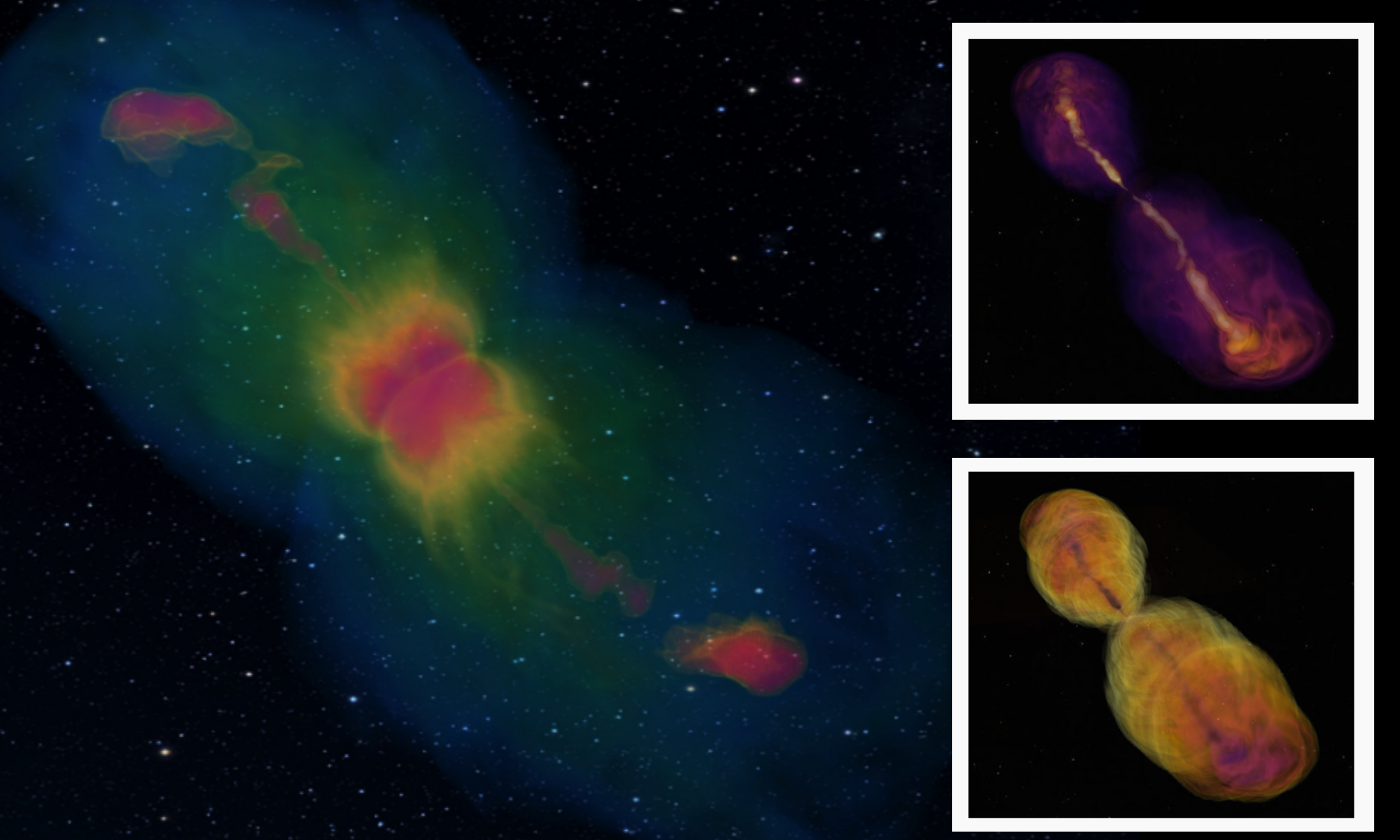New research suggests that fast blue optical transients — 10 times more powerful than supernovas — may be emitted by cocoons that form around jets from dying stars.

FBOT images from new model. Image Credit: Ore Gottlieb/Northwestern University
Discovered in 2018, fast blue optical transients (FBOTs) are some of the brightest optical phenomena in the universe and have proved to be quite a mystery for astrophysicists. With temperatures so high that they glow blue, the origins of FBOTs have, thus far, been unclear.
Now researchers from Northwestern University may have hit upon a mechanism that creates these powerful and bright optical bursts — the most famous and first example of which is a cosmic blast known as the Cow.
The team has developed a new physical model that suggests that FBOTs could emerge from the actively cooling cocoons that surround astrophysical jets launched by dying stars.
The astrophysicists have published their findings in a paper featured in the latest edition of the journal the Monthly Notices of the Royal Astronomical Society.
Throughout their lives, stars are locked in a battle between the outward pressure provided by nuclear fusion and the inward force of their own gravity. When a massive star runs out of fuel this balance is broken and the star collapses under its own gravity.
As this collapse proceeds, outflows or jets of debris are launched from the star core at near-light speeds. These jets drill through the outer layers of the star, forming a cocoon around them as they do so.
The jet continues at these tremendous speeds carrying with it the cocoon. In the model put forward by the Northwestern astrophysicists, the energy of the cocoon matches that of the bright and powerful FBOTs.
This indicates that as the jet travels, dragging its envelope, the cocoon cools and releases heat that is seen as an FBOT.
Holy Cow! What are FBOTs and Why Are They So Mysterious?
On June 16, 2018, astronomers spotted a powerful cosmic burst unlike anything seen before. The event— which was designated AT2018cow — the last three letters giving it its unusual nickname — was at least 10 times as powerful as a supernova.
The sudden explosion of light, which was located 200-million light-years away, lasted three days, fading over the next few months. Initial explanations would include a monster black hole shredding a passing star or a supernova giving birth to a black hole or a neutron star.
This latter theory has led to FBOTs being linked with gamma-ray bursts (GRBs), another transient event from jets that arise from the collapse of a massive star and the creation of a black hole.
Since then, a select few FBOTs have been spotted, marked by a cosmic explosion detected at first in optical light and disappearing almost as rapidly as they appear. Reaching their optical peak in just a few days and quickly fading, FBOTs peak and decay much faster than a conventional supernova.
Video Credit: Ore Gottlieb/Northwestern University
Both FBOTs and GRBs are extremely fast — racing through space at near the speed of light — but another connection is the fact that both bursts are asymmetrically shaped, differing from the spherical shape of a star.
Yet, there is a key difference between FRBs and GRBs that prevented the link from being solidified. Stars that produce GRBs lack hydrogen, thus the tell-tale signs of the Universe’s lightest element are absent in these cosmic bursts.
In contrast, FBOTs are abundant in hydrogen.
Solving the FBOT Hydrogen Problem
The Northwestern team believes that the reason FBOTs are covered in hydrogen is related to their journey through the outer layers of the star from which they originate.
The astrophysicist’s model suggests that in hydrogen-rich stars, the outer layers are packed with this primordial element. As the jet pushes outwards these outer layers restrain it, thus the jet fails to escape the star. This explains why a GRB is not created.
The cocoon, however, does escape, carrying with it the energy of the jet. The cocoon emits the FBOT with hydrogen emissions present, consistent with observed FBOTs.
The model put forward by the team is also consistent with observations in that it explains not just the optical light aspects of FBOT, but also the radio wave and X-ray emissions associated with these outbursts.
The research suggests that as the cocoon interacts with dense gas around its parent star this material is heated, producing the observed radio emissions. The X-ray emissions occur when the collapsed star is a black hole and the cocoon has expanded far from it.
Though the research provides a full picture of FBOTs and their production, accessing whether this is the correct picture will require much more observation of these scarce events. In particular, researchers will aim to observe the evolution of such events — still a relatively new astronomical phenomenon.
More from AZoQuantum: First Image of the Milky Way’s Supermassive Black Hole Explained
References and Further Reading
Gottlieb. O., Tchekhovskoy. A., Margutti. R., [2022], Shocked jets in CCSNe can power the zoo of fast blue optical transients, Monthly Notices of the Royal Astronomical Society, [https://doi.org/10.1093/mnras/stac910]
Kazmierczak. J., [2019], Holy Cow! Mysterious Blast Studied with NASA Telescopes, NASA JPL, [https://www.jpl.nasa.gov/news/holy-cow-mysterious-blast-studied-with-nasa-telescopes]
Disclaimer: The views expressed here are those of the author expressed in their private capacity and do not necessarily represent the views of AZoM.com Limited T/A AZoNetwork the owner and operator of this website. This disclaimer forms part of the Terms and conditions of use of this website.